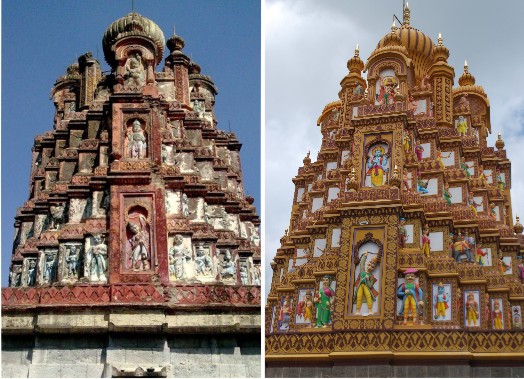By Savitha Hira
Photography: Courtesy Kimaya Architects
The
2014 UNESCO Asia-Pacific ‘Award for Merit’ in Cultural Heritage Conservation
goes to the restoration of Shri Sakhargad Niwasini Devi temple complex in
Satara by Architects Anjali and Kiran Kalamdani of Kimaya Architects, Pune…
Built in the 18th century, the Yamai or Sakhargad Niwasini temple complex, with its different structures and unique, extensive
fortifications, is full of
surprises in terms of fine craftsmanship, unique and popular folk art, graceful
fusion of Yadava Period and Bahamani styles of architecture - a fine example of Kinhai village in Satara district of Maharashtra, which also displays a
surprisingly accomplished level of craftsmanship in its brick, stone, clay,
tile and wood buildings as well as wadas
(traditional houses) and temples as examples of local architecture.
Venerated for her miraculous powers by the
locals of the Kinhai village, the Goddess Yamai Devi has been worshipped for
over two-and-a-half centuries and the conservation and restoration of her
temple addresses its extensive historic and religious associations
with the people of the region, along with its presence as an architectural
landmark.
As with any heritage property (although, surprisingly this site does not
come under the heritage umbrella), here also, weathering, vandalism, structural deterioration and consequent seepage,
deep-rooted vegetative growth, and overall extensive neglect were the main areas
of the restoration and conservation exercise.
 |
| Before Shikhar Restoration After |
.jpg) |
| Before Restoration of S. W. Gateway After |
Key conservation interventions addressed have therefore been to:
a) the Shikhar or tower, where corrosion of all pinnacles and their supporting fixtures of the spire;
and over 144 iconographic images, floral bands
and cornices had been subjected to weathering conditions with harsh winds and
lashing rains. After removal of cracked and weathered parts, the older fabric
was consolidated in similar material (1:3 lime sand mortar using hydraulic lime
as in the traditional manner). The external finish of the lime stucco had
integral pigments with only finer details (eyes, fabric designs etc) painted
over, which were restored to their original format. In few instances, original
finishes with patterns and motifs were retained and consolidated.
b) Partial replacement work to the Gabhara (Inner
Sanctum) and the Sabha Mandapa (Assembly Pavilion) entailed careful removal of oil
paint used over the original stonework and woodwork without damaging the
surfaces. Many structural defects like leakage, cracking in the stonework and
wood work were observed after removal of paint and were rectified with minimal
intervention.
c) Roof-work has involved removing layers of cement
based waterproofing and replacing it with lime based methods. In the case of
tiled roofs, a layer of aluminum sheets was introduced to ensure no damage by
the occasional rains that crept through the gaps in the clay tiles.
Overall, the project, which covers about 1500
sq. m. has taken about four-and-a-half years to reach its completion
stage. Kiran Kalamdani and Anjali Kalamdani,
partners at Kimaya Architects assisted by an able team have ensured the
conservation process in accordance with self-bound regulations like use of
local materials (sourced within a radius of 100 - 300 kms) and traditional
technology, conservation of traditional skills and knowledge systems, minimal
and reversible interventions, minimal loss of fabric and retention of visual
identity.
The temple is clearly built
in different stages thus inheriting the architectural styles of each period in
which it was built. The Gabhara (Inner
Sanctum) was built in the Yadava style with monolithic stone work, the Shikhar -
in the Early Maratha style and the Mandapa (Assembly Pavilion) in the Late
Peshwa style. As seen in the plastering of the Shikhar, the pigment used
(Haldi-kumkum/ Red-Yellow Ochre combination) formed an integral part of the
lime plastering. A similar technology was adopted in the painting works for the
temple, conserving traditional skills and knowledge systems.
Despite being subjected to harsh climatic
conditions, this temple still stands in a good condition - a testimony to the
advanced structural systems used in building the complex.

.jpg)
.jpg)
.jpg)
.jpg)
.jpg)
.jpg)
.jpg)
.jpg)
Beautifully restored. It must be a viewers delight to see this restored to it`s origional glory and a wonderful symbol of the beautiful architecture for years to come . The award is truly a well deserved one
ReplyDeleteIt is indeed the most commendable restoration project in the Satara district of Maharashtra.i am profoundly happy to have seeked blessings and loved everything about this temple
ReplyDelete